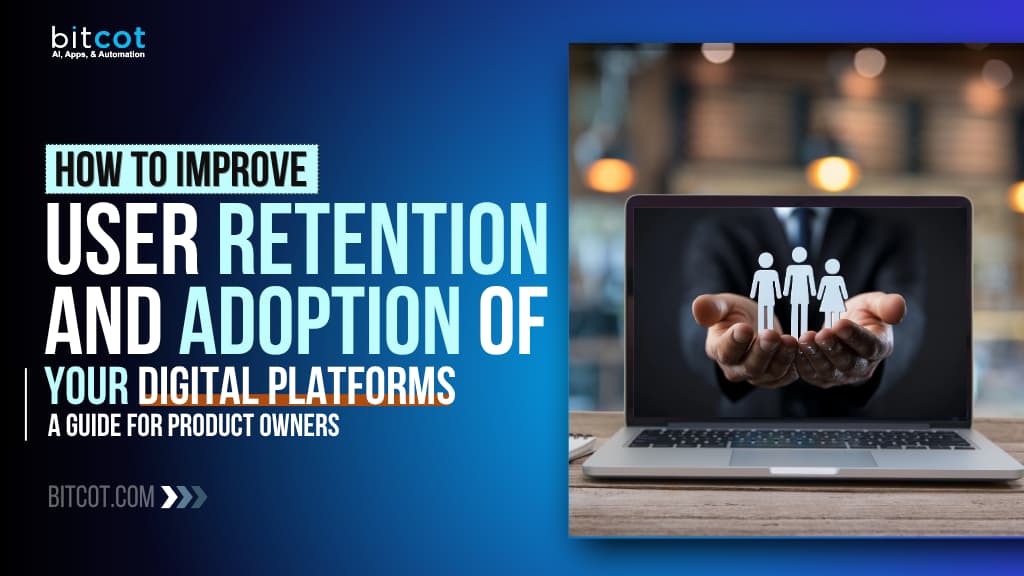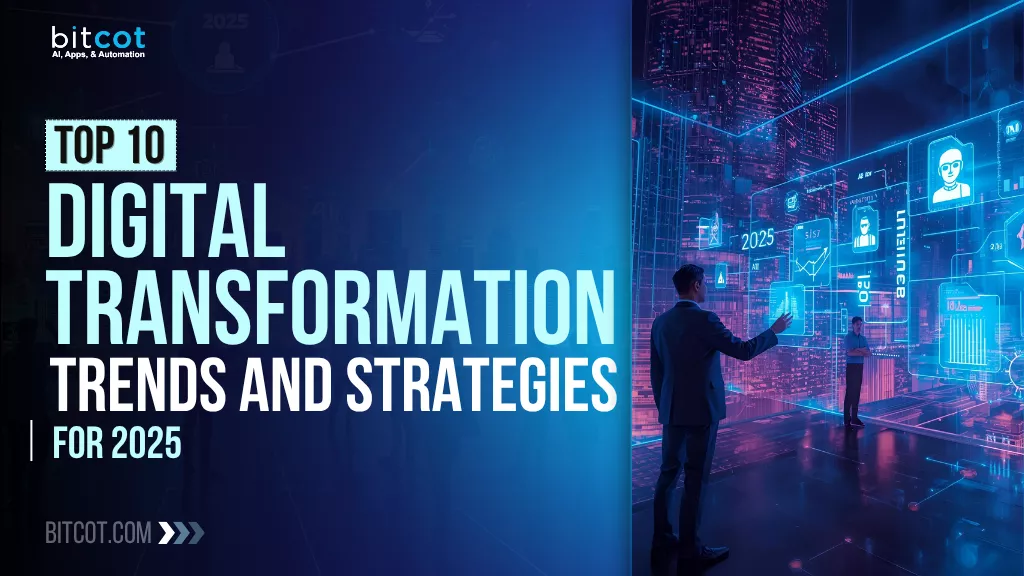
Your users click, tap, and scroll across every touchpoint: your website, mobile app, internal tools, and digital products, expecting everything to work seamlessly, instantly, and intuitively.
But when your platforms don’t guide them, don’t engage them, or don’t adapt to their needs, every session feels like starting from scratch. Your team spends more time fixing drop-offs than driving growth, while your users quietly slip away.
Sound familiar?
Today’s users expect frictionless onboarding, personalized experiences, and immediate value. When your product falls short, when navigation is confusing, features go unnoticed, or support comes too late, you risk losing the very people you worked hard to acquire.
In this post, we’ll break down the practical steps to improve user retention and adoption across your digital platforms, from optimizing onboarding flows and nudging feature discovery to building engagement loops and analyzing user behavior. You’ll get clear examples, proven tactics, and a simple framework you can start applying today.
Ask yourself:
- How many users sign up but never return?
- How many valuable features go unused?
- You already see the symptoms, but what are you doing today to fix them?
Whether you’re a product owner, a non-technical leader, or part of a product team, this challenge is real. Every abandoned session is a missed opportunity to deliver value, build loyalty, and grow sustainably.
But the good news? User-centered, data-driven product strategies are transforming retention and adoption. They help you understand what users need, when they need it, and how to guide them toward success, consistently.
Bitcot helps you make that shift. We design and optimize digital experiences that keep users engaged, help teams make smarter decisions, and drive measurable product growth.
The future of product success is no longer about acquisition alone; it’s about keeping users active, satisfied, and coming back.
Are you ready to move from reactive fixes to meaningful retention?
What Is User Retention and Adoption?
If you want to improve how people interact with your digital platform, it helps to start with two core concepts: user adoption and user retention. These ideas are closely connected, yet they describe different stages in the customer journey and require different strategies to influence.
User adoption focuses on the earliest part of the experience. It begins the moment a new user arrives on your platform, signs up, and starts exploring what you offer. Strong adoption means people understand how to get started, find value quickly, and feel encouraged to continue using your product.
This stage is shaped by onboarding flows, feature clarity, intuitive navigation, and the amount of guidance you provide. When adoption is weak, users often become confused or overwhelmed and leave before they ever see the true value of your platform.
At a high level, adoption answers questions such as:
- Do new users understand what to do when they first arrive?
- Can they reach an early success moment without friction?
- Are the first few interactions clear, helpful, and motivating?
- Do they feel confident that the product will solve their problem?
Once users get past the beginning stage, retention becomes the key focus. User retention reflects how consistently people return, how deeply they engage, and how long they stay active.
Strong retention indicates that your platform continues to deliver value well beyond the onboarding phase. It shows that users are forming habits, solving ongoing problems, and trusting your product enough to keep coming back. Poor retention usually means users tried the platform, saw some value, and then left because the experience was not compelling or essential in the long run.
Both adoption and retention matter, but they matter in different ways. Adoption brings users in. Retention keeps them engaged. If one is missing, the entire user journey becomes unstable. Strong adoption with low retention results in churn, and strong retention with slow adoption results in limited growth.
For product owners, understanding the difference allows you to pinpoint where improvements will have the greatest impact. When you balance both, you build a digital platform that attracts users, keeps them engaged, and supports long-term product success.
| Category | User Adoption | User Retention |
| Definition | The process of new users learning, understanding, and starting to use your product’s core features. | The ongoing ability to keep users coming back and consistently engaging with your product over time. |
| Primary Goal | Help users reach the “Aha Moment” quickly and see immediate value. | Maintain long-term engagement and prevent users from dropping off. |
| Focus Area | Early-stage experience: onboarding, first impression, initial feature usage. | Long-term experience: continued value, habits, satisfaction, and loyalty. |
| Success Indicators | Activation rate, onboarding completion, time-to-value, and first key action. | DAU/MAU, churn rate, repeat usage, subscription renewals, customer lifetime value. |
| Challenges | Confusing onboarding, unclear value proposition, overwhelming first-time UX. | Lack of ongoing value, poor communication, feature fatigue, and better competitors. |
| What Drives It | Clear guidance, intuitive design, personalized onboarding, and quick wins. | Continuous product improvement, meaningful features, support, habit loops. |
| User Mindset | “Is this product worth using?” | “Is this product still worth using?” |
| Typical Timeframe | First day, first week, or first few interactions. | Weeks, months, or long-term usage patterns. |
| Business Impact | Determines if users will give your platform a real chance. | Determines long-term revenue, growth, and stability. |
| Examples | Users signing up, completing setup, exploring main features. | Users returning daily/weekly, renewing subscriptions, upgrading plans. |
Why User Retention and Adoption Matter
Now that we have defined what adoption and retention are, the next question is why they matter so much for product owners.
The simple answer is that these two metrics tell you whether your digital platform is actually delivering value and doing so in a sustainable way. They act as indicators of health, growth, and long-term stability.
Adoption matters because it shows whether people can quickly understand your product and see a reason to keep going. If users struggle during their first moments, the rest of the journey never happens. Strong adoption creates momentum and helps you turn curious visitors into active users who are ready to engage more deeply.
Retention matters because it reflects whether your platform continues to meet user needs over time. High retention means your product has become part of someone’s routine. It signals trust, satisfaction, and consistent value. Low retention, on the other hand, can highlight gaps in usability, missing features, or experiences that fail to evolve with user expectations.
For product owners, these two metrics support better decision-making because they help you:
- Understand which parts of the user journey need improvement
- Prioritize initiatives that have real business impact
- Identify friction points before they lead to churn
- Align product development with actual user behavior instead of assumptions
- Build a platform that grows steadily instead of relying only on new signups
When retention and adoption improve together, you create a digital ecosystem that attracts new users, guides them smoothly, and keeps them coming back.
This combination is what allows digital products to scale, stay relevant, and deliver meaningful long-term value.
How to Improve User Retention and Adoption in 4 Steps
So, you’ve built a fantastic digital platform. Maybe it’s an app, a SaaS tool, or a vibrant online community. Congratulations! That initial launch is a massive achievement.
But here’s the reality check: getting users is only half the battle. The real success lies in keeping them engaged (retention) and making sure they actually use all the great features you built (adoption). A leaky bucket of users means all your acquisition efforts are going to waste.
Let’s dive into some practical, friendly ways to turn those first-time visitors into long-term loyalists.
Step 1: Make the First Date a Dream: Mastering Onboarding
Think of onboarding like a first date. If it’s awkward, confusing, or overwhelming, there won’t be a second one. Your goal is to get the user to their first “Aha!” moment as quickly and painlessly as possible.
- Keep it brief and focused: Don’t show them ten tutorial screens. Focus on the one to three essential steps they need to take to get immediate value. For a fitness app, that might be logging their first workout. For a project management tool, it might be creating their first task.
- Use progressive disclosure: Only show them advanced features when they’ve mastered the basics. A complex interface on day one is a huge barrier.
- Give them a win fast: Guide them to complete a meaningful action that delivers on your platform’s promise.
Step 2: The Power of Personalization: Making Them Feel Seen
Nobody wants to feel like just another number. Personalization is key to making your platform feel essential.
- Relevant recommendations: Netflix is the king of this. If your platform has content, features, or products, surface the ones that align with the users’ past behavior or stated preferences.
- In-app messaging that matters: Instead of generic pop-ups, use the data you have. For example, if a user has repeatedly visited your photo editor but hasn’t saved an image, a message might say, “Ready to save your masterpiece? Here’s how the export feature works.”
- Celebrate milestones: Send a brief, encouraging email or in-app notification when they complete their 10th login or use a new feature for the first time. It reinforces good behavior!
Step 3: Communicate Value Constantly: It’s Not Just About New Features
Users often forget why they signed up in the first place, or they simply don’t realize how powerful your tool is. You need to remind them, constantly and gently.
- Highlight underutilized features: See a segment of users who only use one function? Send them a targeted email or quick video showing how another feature can enhance their workflow. Frame it as solving a problem they didn’t know they had.
- Regular, high-quality content: This could be a blog, a newsletter, or tutorial videos. Don’t just talk about your product; talk about the user’s goals and how your platform is the best vehicle to achieve them.
- Solicit and act on feedback: When users feel heard, they are more likely to stay. Set up a simple feedback widget or send out short surveys. Critically, close the loop: when you release a feature based on user requests, shout out the people who asked for it (if appropriate).
Step 4: Optimize for Smoothness: Removing Friction
Retention is easily crushed by bad user experience (UX). If your platform is buggy, slow, or requires too many clicks, users will bounce, simple as that.
- Focus on speed: A fast-loading, snappy interface makes the user experience delightful. Delays lead to frustration.
- Simplify key workflows: Map out the most common tasks your users perform. Are there any unnecessary steps? Can you use smart defaults or pre-fill information? The path of least resistance is the path of highest adoption.
- Provide great support: When things go wrong, a quick, helpful, and human support experience can actually increase loyalty. It turns a moment of frustration into a moment of positive connection.
By focusing on a seamless first experience, personalization, continuous communication of value, and a butter-smooth platform, you’ll naturally start to see those adoption and retention numbers climb. It’s not about tricking people into staying, it’s about providing so much value that leaving isn’t even an option.
Also Read: Legacy System Modernization and Migration: Key Strategies, Services, and Costs
Key Strategies for Improving User Retention of Your Digital Platforms
Building upon the foundations of excellent onboarding and continuous value, here are several advanced and strategic ways to lock in your user base and ensure they keep coming back.
1. Leverage Data and Analytics
You can’t fix what you don’t measure. Data is the key to understanding why users leave and where they stop deriving value.
- Define Your Metrics: Start with the Retention Rate (the percentage of users who return during a specific time period) and the Churn Rate (the percentage of users who stop using your platform).
- Identify “Magic Moments”: Use data to find the set of actions high-retaining users took early on. For a social app, maybe it’s connecting with 5 friends. For an e-commerce platform, maybe it’s favoriting 3 items. Once you know these, guide new users toward them aggressively during onboarding.
- Analyze Exit Points: Use tools like funnels and heatmaps to see where users drop off in key workflows. Is your checkout process too long? Does setting up a profile require too much input? Fix these points of friction immediately.
- Segment Users: Retention strategies shouldn’t be one-size-fits-all. Segment users by usage frequency (e.g., daily, weekly, monthly) or by feature adoption. This allows you to tailor win-back campaigns and feature announcements much more effectively.
2. Implement Effective Habit Loops
Habit formation is the ultimate goal of retention. Users who use your product without thinking about it are the ones who stay forever. The core of a habit loop involves three elements: Cue, Routine, and Reward.
- The Cue (Trigger): What prompts the user to open your platform? This can be internal (boredom, need for information) or external (a push notification, an email). Design external cues that are helpful and timely, not annoying.
- The Routine (Action): The action the user takes on your platform. Make this as easy and frictionless as possible.
- The Reward (Variable Reinforcement): The benefit the user gets. This should be a mix of satisfying immediate needs and providing delightful, unexpected moments (variable rewards).
For example, a productivity app provides the immediate reward of task completion (satisfaction) and the variable reward of an occasional congratulatory animation or a summary of progress over the week.
3. Build a Thriving Community
Users don’t just retain based on features; they retain based on network effects and emotional attachment. A community transforms your platform from a tool into a destination.
- Facilitate Peer-to-Peer Interaction: Provide forums, chat groups, or comment sections that let users help each other, share tips, and celebrate wins. This builds a sense of belonging.
- User-Generated Content (UGC): Encourage users to create content within your platform (e.g., templates, profiles, reviews). When users invest their time and creativity, it dramatically increases their switching cost.
- Establish a VIP/Loyalty Program: Reward your most loyal users with exclusive badges, early access to new features, or special support channels. Recognizing their loyalty reinforces their commitment.
4. Strategic Win-Back Campaigns
Inevitably, some users will become inactive (dormant). A strategic, targeted campaign can bring many of them back before they officially churn.
- Identify the ‘At-Risk’ Signal: Don’t wait until a user hasn’t logged in for 60 days. Identify at-risk users based on a drop in their typical usage pattern (e.g., a daily user hasn’t logged in for 3 days).
- Offer Targeted Value: Don’t send a generic “We miss you” email. Based on the last feature they used or the point they dropped off, offer them a relevant incentive:
▸“We fixed that bug you reported!”
▸“Check out the new feature you asked for!”
▸A limited-time discount or a small, free premium feature trial. - The Farewell Survey: When a user explicitly cancels or deletes their account, send a brief, non-intrusive survey asking why. This is gold for identifying systemic problems that affect other users.
By proactively using data, engineering habit-forming experiences, fostering a sticky community, and strategically winning back at-risk users, you create a robust ecosystem that prioritizes long-term relationships over short-term sign-ups.
Key Strategies for Driving Adoption of Your Digital Platforms
Now that we know how to hold onto our users, the next crucial step is making sure they actually use the full depth and breadth of your platform, what we call adoption.
A retained user who only uses 10% of your features is a lost opportunity.
Adoption is all about turning curiosity into commitment.
1. Contextual In-App Guidance: The Right Nudge at the Right Time
Forget lengthy, generic email guides. The most effective way to drive feature adoption is to educate the user right when they need the information, inside the platform itself.
- Interactive Walkthroughs: Instead of static tours, use step-by-step guides that only activate when the user is in a specific part of the app. This is the difference between reading a manual and having a friendly co-pilot.
- Tooltips and Hotspots: Use subtle visual cues like small pulsing dots or tooltips to highlight a new or underutilized feature. These cues should disappear once the user clicks or interacts, preventing clutter.
- Targeted Announcements: Segment your users before you announce a new feature. Only show the announcement banner or modal to the segment of users who would genuinely benefit from it based on their role or past behavior. Relevance is everything.
2. Gamification and Incentives: Make Usage Fun
People love feeling successful. Gamifying the adoption process encourages exploration and builds motivation.
- Progress Bars and Checklists: Nothing motivates like a visual representation of progress. An “Onboarding Checklist” or a “Profile Completion Bar” gives users a clear path to follow and a little hit of dopamine every time they check an item off.
- Badges and Rewards: Award virtual badges for achieving feature milestones. For example, a “Power User” badge for using the advanced reporting feature three times, or a “Collaboration Expert” badge for inviting five teammates.
- Offer Incentives: For premium features, consider offering a limited-time free trial or a small discount only after a user completes a related task in the free tier. This removes the financial barrier to trying something new.
3. Simplify and De-clutter the Interface
The fastest way to kill adoption is feature overwhelm. When users look at your interface and feel confused, they retreat to the one or two things they know.
- Curate the Experience: Your homepage or dashboard should not display every single feature. Prioritize the most-used features and the ones that drive the core “Aha!” moment.
- Progressive Disclosure: This bears repeating: roll out complexity slowly. You can hide advanced settings or less common features behind a simple “Advanced” toggle or a secondary menu. The goal is to keep the initial view clean and focused on essential tasks.
- A/B Test Placement: Experiment with the placement and wording of your calls to action. A small change, like moving a button or changing the label from “Configure Settings” to “Personalize Your View,” can drastically increase click-through rates.
4. Continuous Customer Education
Adoption is a long-term project. Users constantly evolve, and so does your platform. You need a centralized resource that grows with them.
- Role-Based Training: Create educational content (videos, webinars, written guides) tailored to different user personas. A manager needs to know how to review work, while a contributor needs to know how to create it. Address their specific use cases.
- In-Platform Resource Center: Create a searchable help widget or resource center accessible directly within the platform. This lets users find answers without leaving their workflow, drastically reducing friction and support requests.
- Case Studies and Success Stories: Use external content to showcase the outcomes of using your features. Showing how one customer saved 10 hours a week using your automation tool is far more compelling than simply listing the automation tool’s capabilities.
By focusing on making features easy to discover, fun to use, and clearly valuable, you move users from simply having an account to actively and enthusiastically using your platform to its fullest potential.
Partner with Bitcot to Accelerate User Retention and Adoption
Driving long-term user retention isn’t just about building features; it’s about creating meaningful digital experiences that users understand, trust, and come back to every day.
At Bitcot, we help product owners bridge the gap between user expectations and product performance through thoughtful design, smart engineering, and continuous optimization. Whether you’re improving an existing platform or building a new one from scratch, we’re here to help you deliver impactful, measurable results.
With experience across SaaS platforms, mobile apps, web apps, and enterprise systems, we know what it takes to create products that succeed in competitive markets.
Our approach emphasizes clarity, usability, and long-term scalability, ensuring your platform not only attracts users but keeps them engaged and satisfied over time.
Here’s how we help you succeed:
- We reduce churn by designing user-centered experiences that simplify workflows and remove friction.
- We increase activation rates with onboarding experiences that guide users smoothly toward early value.
- We boost engagement through intuitive UI/UX, habit-forming features, and personalized experiences.
- We grow lifetime value by continuously improving your product based on real user behavior and insights.
- We support growth and scale with reliable engineering and architecture built for long-term performance.
If your goal is to create a platform that users adopt quickly, engage with consistently, and rely on every single day, we’re here to help you bring that vision to life.
Our end-to-end approach ensures that every element of your product, from user experience to backend performance, is aligned with improving user adoption and retention.
Final Thoughts
At the end of the day, improving user adoption and retention doesn’t require magic; it just requires intention.
Small, thoughtful changes to onboarding, design, communication, and feature value can create a huge difference in how users experience your product. Most importantly, it’s an ongoing process. Your users will evolve, expectations will shift, and your product should adapt right along with them.
If you’re feeling the pressure to keep up or simply want to make your platform easier, clearer, and more engaging, you don’t have to figure it out alone.
At Bitcot, we blend practical product strategy with real-world experience to help teams build digital experiences that people truly enjoy using. Whether you’re refining an existing product or planning something entirely new, our digital transformation services are here to support you every step of the way.
Ready to take your user experience to the next level? Let’s build something your users will love, together.
Contact Bitcot today.












